Alessandro Bonvicino, more famously known as Il Moretto da Brescia (c. 1498 – 1554), stands as a pivotal figure in the North Italian Renaissance. His artistic legacy is characterized by a unique synthesis of Venetian colorism and Lombard realism, resulting in works of profound spiritual depth, serene dignity, and remarkable observational acuity. Active primarily in his native Brescia and the surrounding territories, Moretto carved out a distinct artistic identity, excelling in both devotional altarpieces and insightful portraiture, leaving an indelible mark on the Brescian school and influencing subsequent generations of artists.
Early Life and Artistic Formation
Born in Rovato, a small town near Brescia, around 1498, Alessandro Bonvicino's early life is somewhat shrouded in the mists of time, common for many artists of his era. His moniker, "Il Moretto," meaning "the little Moor" or "the dark one," likely referred to his complexion. He hailed from a family with artistic inclinations; his father, Pietro Bonvicino, and his uncle, Alessandro, were modest painters, suggesting an early immersion in an artistic environment. This familial background likely provided his initial exposure to the rudiments of painting.
The precise nature of Moretto's formal training remains a subject of scholarly debate. Early sources, including Giorgio Vasari in his "Lives of the Most Excellent Painters, Sculptors, and Architects," offer somewhat conflicting or incomplete accounts. It is widely believed that he may have apprenticed under Floriano Ferramola, a prominent Brescian painter at the time. Records indicate Moretto assisted Ferramola between 1516 and 1518 in decorating the organ shutters for the Duomo Vecchio (Old Cathedral) of Brescia. Another potential early influence or master could have been Vincenzo Foppa, a foundational figure of the Lombard school, whose emphasis on solid form and sober realism was a hallmark of the regional style.
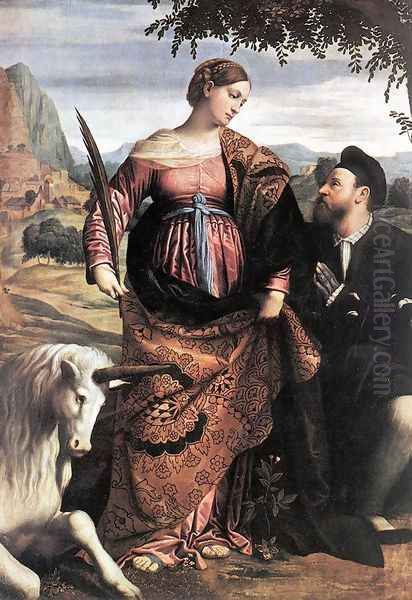
While a direct apprenticeship with Titian (Tiziano Vecellio) is often mentioned, particularly in older literature, this is now largely considered unlikely. However, the profound impact of Venetian painting, especially the works of Titian, Giovanni Bellini, and Giorgione, on Moretto's development is undeniable. Brescia, under Venetian rule during much of Moretto's lifetime, was a conduit for artistic exchange, and it is highly probable that Moretto absorbed Venetian influences through the study of available works and possibly through visits to Venice itself.
The Artistic Milieu of Brescia
To fully appreciate Moretto's contribution, it's essential to understand the artistic context of Brescia in the early 16th century. Lombardy, and Brescia within it, had a strong tradition of naturalism and a certain gravitas in its artistic expression, distinct from the more idealized forms of Central Italian art or the opulent chromatic brilliance of Venice. Artists like Vincenzo Foppa and later Bramantino had laid a foundation for a style that valued direct observation and a somewhat austere dignity.
However, Brescia's political allegiance to Venice also meant that Venetian artistic currents were strongly felt. The city became a melting pot where Lombard traditions encountered the burgeoning High Renaissance style of Venice, characterized by rich color, atmospheric effects, and dynamic compositions. Moretto, along with his contemporary and sometimes collaborator Girolamo Romanino, became a leading exponent of this Brescian synthesis. While Romanino often leaned towards a more robust, energetic, and sometimes rustic interpretation, Moretto cultivated a style marked by greater refinement, psychological depth, and a distinctive, often cool and silvery, palette.
Development of a Unique Style
Moretto's artistic journey reveals a gradual assimilation and masterful blending of these diverse influences. His early works show a clear debt to Ferramola and the Lombard tradition, but soon the impact of Venetian art becomes apparent. He adopted the Venetian emphasis on color and light to model form and create atmosphere, yet he tempered this with a Lombard sense of restraint and a keen eye for realistic detail.
A hallmark of Moretto's style is his sophisticated use of color, often favoring cool, silvery tones, particularly in his draperies and backgrounds, which lend his paintings a distinctive luminosity and elegance. His figures possess a quiet dignity and an introspective quality, often conveying deep piety without resorting to overt emotionalism. This balance between Venetian richness and Lombard sobriety became his signature. He was particularly adept at rendering textures – the sheen of silk, the glint of armor, the softness of flesh – with remarkable verisimilitude.
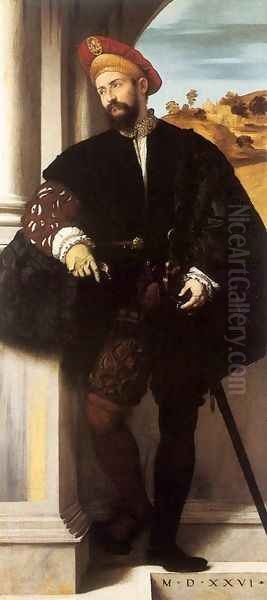
His compositions are typically well-balanced and harmonious, often employing architectural settings that enhance the solemnity of his religious scenes. He demonstrated a profound understanding of human anatomy and a subtle grasp of psychology, particularly evident in his portraits and the expressive faces of his sacred figures.
Masterpieces of Religious Art
Moretto was, first and foremost, a painter of religious subjects, and his altarpieces and devotional paintings constitute the core of his oeuvre. These works were deeply informed by the religious currents of his time, including the nascent stirrings of the Catholic Reformation, which called for art that was clear, devout, and capable of inspiring piety.
One of his early significant commissions was the Standard of the Holy Cross (c. 1520-1521, Pinacoteca Tosio Martinengo, Brescia), which already displays his ability to handle complex compositions and imbue figures with a sense of gravity. His Assumption of the Virgin in the Duomo Vecchio of Brescia (1524-1526) is a monumental work showcasing his maturing style, with its dynamic arrangement of figures and rich, though controlled, color.
Throughout the 1520s and 1530s, Moretto produced a series of remarkable altarpieces for churches in Brescia and nearby towns. Works like Saint Margaret of Antioch with Saints Jerome and Francis of Assisi (c. 1530, San Francesco, Brescia) and the Madonna and Child with Saint Roch and Saint Sebastian (Pinacoteca Tosio Martinengo, Brescia) exemplify his ability to create serene and moving sacre conversazioni (holy conversations), where saints are depicted in attendance upon the Virgin and Child.
His Supper at Emmaus (c. 1526, Pinacoteca Tosio Martinengo, Brescia) is a particularly compelling piece, noted for its intimate atmosphere, the realistic depiction of the figures (including a charming portrayal of the innkeeper's daughter), and the subtle play of light. This work demonstrates Moretto's skill in humanizing sacred narratives, making them relatable to the contemporary viewer.
The Enthroned Madonna and Child with Saints James Major and Jerome (c. 1517-1520, High Museum of Art, Atlanta, though sometimes titled with other saints like John) is another example of his ability to create a sense of calm devotion. Christ in the Wilderness (or Christ in the Desert), of which several versions exist, showcases his capacity for conveying solitude and spiritual contemplation. The Holy Family with the Infant Saint John the Baptist (e.g., version in the National Gallery, London) highlights his tender portrayal of familial bonds within a sacred context.
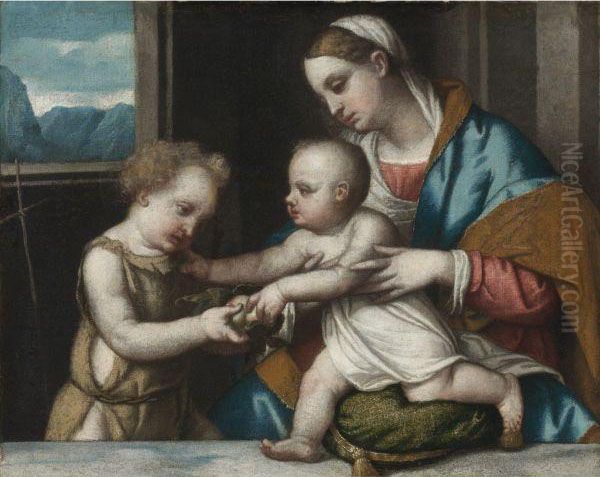
Moretto also collaborated with Girolamo Romanino on the decoration of the Chapel of the Sacrament in San Giovanni Evangelista, Brescia (1521-1524). While their styles differed, their joint efforts contributed significantly to the artistic richness of the city. Moretto's contributions, such as The Last Supper and scenes from the Old Testament, are characterized by their compositional clarity and dignified figures.
His later religious works, such as the Coronation of the Virgin with Four Saints (c. 1535-1540, Santi Nazaro e Celso, Brescia) and the poignant Pietà (c. 1525-1530, National Gallery of Art, Washington D.C.), continue to display his mastery of color, light, and emotional expression, often imbued with a heightened sense of spiritual intensity that reflects the growing concerns of the Counter-Reformation. St. Justina with a Donor (or St. Justina with the Unicorn, c. 1530, Kunsthistorisches Museum, Vienna) is a particularly elegant and iconic work, showcasing his refined aesthetic.
Pioneering Portraiture
Beyond his religious commissions, Moretto da Brescia made significant contributions to the genre of portraiture. He is considered one of the pioneers of the independent full-length portrait in Italy, a format that had previously been rare. While Giorgio Vasari attributed the popularization of this format primarily to Titian, Moretto's Portrait of a Gentleman dated 1526 (National Gallery, London) predates comparable full-length works by Titian by several years.
This striking portrait depicts an unknown nobleman standing confidently in a richly appointed interior, his hand resting on his sword. The painting is remarkable for its psychological insight, the meticulous rendering of costume and setting, and the overall sense of aristocratic poise. Moretto's portraits are characterized by their sober elegance, their ability to capture the sitter's social status, and a subtle revelation of their inner character. He often employed a somewhat muted palette in his portraits, which served to emphasize the sitter's presence and personality.
Other notable portraits include the Portrait of a Young Man (National Gallery, London) and various depictions of Brescian nobility. These works demonstrate his keen observational skills and his ability to convey individuality without sacrificing a sense of decorum. His approach to portraiture, with its emphasis on realism and psychological depth, would prove highly influential, particularly on his most famous pupil, Giovanni Battista Moroni.
Collaborations and Contemporaries
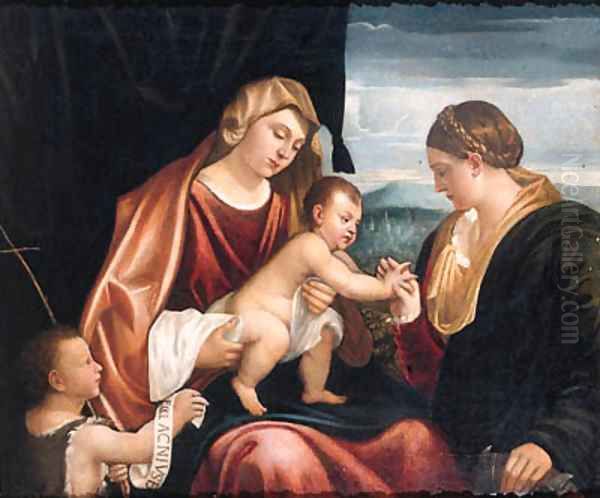
Moretto's career unfolded within a vibrant artistic community. His most significant local contemporary was Girolamo Romanino, with whom he shared major commissions, as noted in the Chapel of the Sacrament. While their artistic temperaments differed—Romanino being more exuberant and Moretto more classical and restrained—their rivalry and collaboration spurred artistic innovation in Brescia.
Lorenzo Lotto, a Venetian painter who spent periods working in Bergamo and the Veneto mainland, was another important contemporary whose work Moretto would have known. Lotto's intense psychological realism and unconventional compositions may have offered another point of reference for Brescian artists. There is evidence of friendship and mutual respect between Moretto and Lotto, and they collaborated on projects, for instance, in Santa Maria Maggiore in Brescia.
The influence of Venetian giants like Titian, Giorgione, and Palma Vecchio was pervasive. Moretto skillfully adapted Venetian chromatic richness and atmospheric effects to his own more grounded Lombard sensibility. He also seems to have been aware of developments in Central Italian art, possibly through prints or travelling artists, and some scholars detect echoes of Raphael's grace in certain of Moretto's figures, leading to him sometimes being dubbed the "Raphael of Brescia."
His workshop was active, and he trained a number of pupils. The most distinguished of these was Giovanni Battista Moroni, who would go on to become one of the leading portraitists of the 16th century, further developing the realistic and psychologically astute style of portraiture pioneered by his master.
Later Career and Workshop
In his later career, Moretto continued to be highly productive, receiving numerous commissions for altarpieces and devotional paintings. There is some suggestion that, like many successful artists of the period, his workshop played an increasing role in the execution of commissions, particularly in his final years. This was a common practice, allowing masters to meet high demand.
Some accounts suggest that Moretto may have faced economic pressures in his later life, leading to practices such as dividing larger compositions into smaller, more marketable individual paintings. However, he remained a respected and sought-after artist until his death.
His artistic output remained consistently high in quality, characterized by a mature synthesis of his stylistic traits. Works from this period often exhibit a deeper spiritual intensity and a refined, almost ethereal, use of his signature silvery light. He continued to explore complex theological themes, reflecting the evolving religious climate of the era.
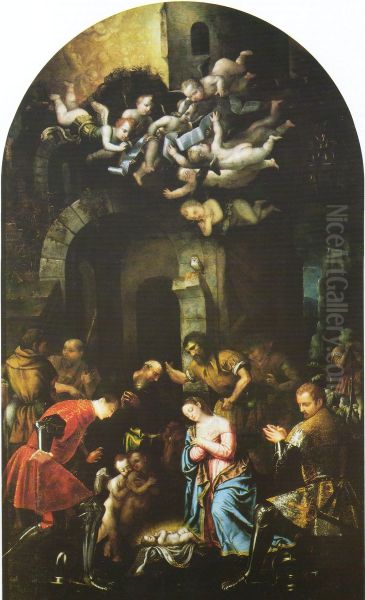
Moretto da Brescia died in Brescia, likely in December 1554, leaving behind a substantial body of work that had significantly shaped the artistic landscape of Lombardy.
Legacy and Influence
Moretto da Brescia's influence was considerable, both in his own time and on subsequent generations. He, along with Romanino and Savoldo, established Brescia as a significant center of painting in the 16th century, known for its distinctive blend of Venetian and Lombard characteristics.
His most direct artistic heir was Giovanni Battista Moroni, who absorbed Moretto's approach to portraiture and developed it further, achieving an even greater degree of naturalism and psychological penetration. Moroni's portraits, in turn, became highly influential.
More broadly, Moretto's emphasis on realism, his sober dignity, and his sensitive use of light and color contributed to a North Italian tradition of naturalism that would resonate in the work of later artists. Some art historians see a lineage, however indirect, from the Lombard realism exemplified by artists like Moretto to the revolutionary naturalism of Caravaggio, who also had Lombard roots.
His works were collected and admired, and his reputation as a master of the Brescian school endured. While perhaps not as universally famous as contemporaries like Titian or Raphael, Moretto's contribution to Italian Renaissance art is undeniable. He created a unique artistic voice, characterized by a harmonious blend of regional traditions and broader Italian Renaissance innovations. His paintings continue to be admired for their technical skill, their serene beauty, and their profound humanity.
Conclusion
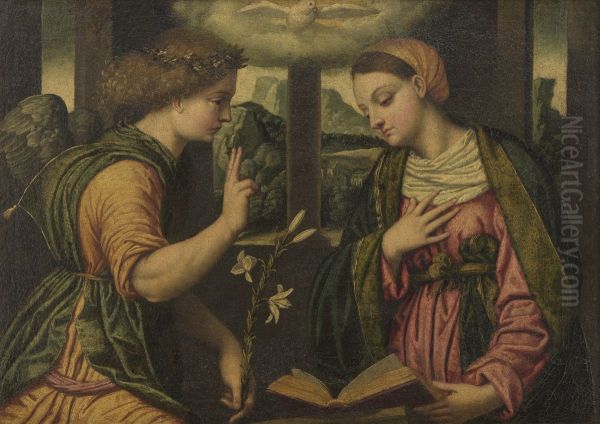
Alessandro Bonvicino, Il Moretto da Brescia, was a painter of exceptional talent and quiet distinction. He navigated the rich artistic currents of his time, forging a style that was both deeply personal and reflective of the unique cultural position of Brescia. His religious paintings inspire contemplation through their dignified piety and subtle emotional depth, while his portraits offer compelling glimpses into the personalities of his sitters. As a master of color, light, and realistic observation, Moretto secured his place as one of the leading figures of the Lombard Renaissance, leaving a legacy that enriched Italian art and continues to captivate viewers today. His ability to infuse Venetian grandeur with Lombard gravitas created a body of work that is both beautiful and profoundly moving, cementing his status as the "Raphael of Brescia" and a cornerstone of North Italian painting.